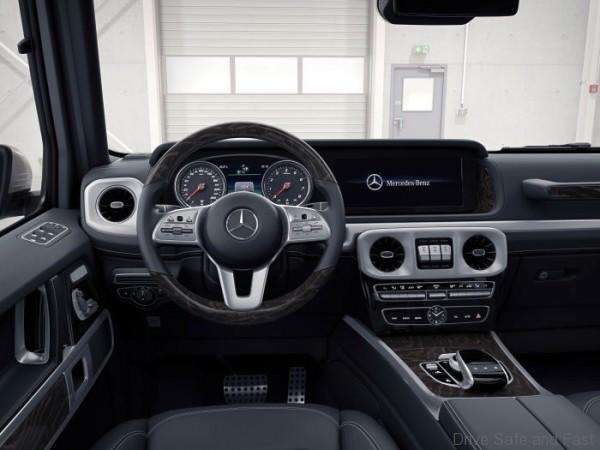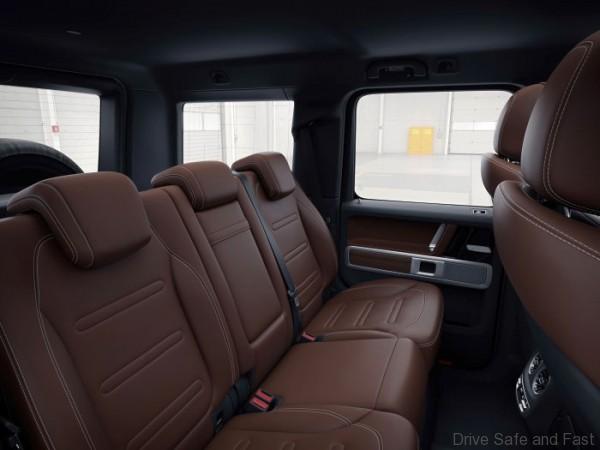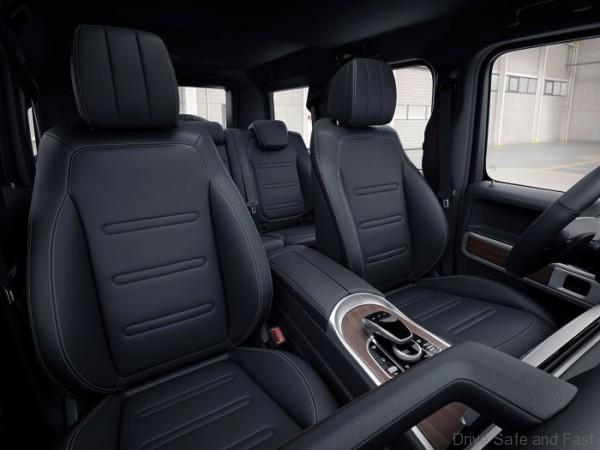The new Mercedes-Benz G-Class presents itself in top form. Whether on or off the road and whatever the operating conditions, the off-road vehicle impresses with its performance, cutting-edge assistance systems, outstanding handling, and safety. At the same time, the new suspension, the DYNAMIC SELECT driving modes, the “G-Mode” and the three 100 percent differential locks enhance not only ride comfort but also agility – on any surface.
At the time of market launch in June, the G-Class will be available at an entry-level price of €107,040.50 (price in Germany, incl. VAT) and thus remains at the level of the preceding version. The specification includes a host of new features such as the LED headlamps, the driving assistance systems, the high-quality interior with leather seats, and the new suspension. For demanding customers, options such as the Exclusive Interior Plus with leather on the interior door panels provide even more exclusivity.
The G-Class, reinterpreted for today
The G-Class, the luxury off-road vehicle from Mercedes-Benz, has long been considered a design icon. Its external appearance has not changed significantly since 1979. Iconic elements continue to serve very specific purposes, now as then, and to give the G Class its unique appearance. All these are still found in the new G Class: the distinctive door handle and the characteristic closing sound, the robust exterior protective strip, the exposed spare wheel on the rear door and the prominent indicator lights. Extraordinary features like these in concert with the off-roader’s angular lines define its special look.
The enhanced design of the G-Class follows the philosophy of Sensual Purity and at the same time remains true to the character of the original. As a result, the door hinges positioned on the outside and the surface-mounted bonnet are carried over to the new generation. With the latest update, the off-road icon – which has been continually enhanced technically over the decades but visually has hardly changed – is making the leap into a new era – both in terms of technology and form. The new G-Class is 53 mm longer and 121 mm wider and now has even greater presence, on the road as well as in terrain.
More than ever, the new G-Class appears to be cast from a single piece. All surfaces have a more taut design and are have more tension, while the surface quality has been taken to an even higher level. This results in narrower, more precise gaps and more harmonious transitions. In addition, the wheel arches and bumpers form a more integral part of the body and thus look less like add-on features.
Interior: authentic icon
While the exterior maintains the iconic classic look, the interior of the G-Class has undergone a fundamental modern redesign which reinterprets the genes of the classic vehicle to reflect the exterior. With its off-road character and top-class luxury appointments, the G-Class has always combined two extremes into a harmonious symbiosis. Unmistakable at first glance and from the first touch, only high-quality materials are used. Every detail is finished by hand with the utmost care.
Getting in the G-Class reveals that numerous design features from the exterior have been transposed into the interior. The shape of the round headlamps, for instance, which is reflected in the side air vents. Or the design of the iconic indicators, found again in the shape of the loudspeakers. Hallmarks of the G Class include the grab handle in front of the front passenger and the chrome-highlighted switches for the three differential locks. Both have been meticulously optimised and retained as characteristic features.
The very clearly arranged and completely redesigned instrument panel features timeless tube-look analogue round dials as standard. In other words, fans of classic round instruments will certainly not be disappointed in the new G Class. As in the new E-Class and S-Class, an instrument cluster in the form of a large display showing virtual instruments in the driver’s direct field of vision and a central display above the centre console is available as an option. In this case the two 12.3-inch displays blend visually into a Widescreen Cockpit beneath a shared glass cover. Drivers can choose between three different styles for the displays – “Classic”, “Sport” and “Progressive” – and also select relevant information and views according to their individual needs.
Thanks to haptic impulses and audible feedback from the on-board speakers, drivers can use the touchpad with controller in the centre console without taking their eyes off the road. The input options are rounded off by shortcut keys in front of the controller for frequently used operating tasks, and by the optional control panel for the driving assistance systems above the rotary light switch. The driver sits up close to the windscreen and enjoys good all-round visibility from behind the wheel.
More space for all
The revised dimensions of the now larger G-Class benefit not only the driver and front passenger, but also the passengers in the second row. Key data at a glance:
Legroom in the front +38 mm
Legroom in the rear +150 mm
Shoulder room in front +38 mm
Shoulder room in rear +27 mm
Elbow room in front +68 mm
Elbow room in rear mm +56 mm
The rear seats can be folded down to 60, 40 or 100 percent. The seats in the G Class are equipped as standard with numerous convenience functions and are ergonomically designed, thus providing enhanced seating comfort and lateral support. Features include the Memory function for the driver’s seat, seat heating front and rear, as well as luxury head restraints in the front. This ride comfort can optionally be boosted still further with the Active Multicontour Seat Package.
In addition to the special multicontour seats, this encompasses such features as various massage functions, climate-controlled seats, and fast seat heating. This variant also offers electrically adjustable lumbar supports for the driver and front passenger. The side sections of the seat cushions and backrests of the active multicontour seats include integrated air chambers that fill or empty continuously depending on the driving dynamics, thus providing better support for the seating positions of driver and front passenger and, for example, offering more lateral support during cornering. The front seats of the Active Multicontour Seat Package are recommended by experts from the German spinal health organisation “Aktion Gesunder Rücken e.V.”.
Off-road: the legend surpasses itself
The primary goal of development was to redefine the quality of the handling both on and off the road. This goal has been achieved: The new G-Class performs even better off-road, while on the road it is significantly more agile, dynamic and comfortable than its predecessor. The G thus remains a true G – thanks to its standard ladder-type frame, the three 100-percent differential locks and LOW RANGE off-road gear reduction.
The new suspension emerged from the collaboration between Mercedes-Benz G GmbH and Mercedes-AMG GmbH. The result is an independent suspension with double-wishbone front axle in combination with a rigid rear axle. As part of their work, the engineers had the task of fighting for every millimeter, because off-road capability not least also means maximum ground clearance. The raising of the axles makes a decisive contribution in this respect, while requiring a strut tower brace in the engine compartment to achieve the ruggedness objectives.
The components of the double-wishbone front axle are directly mounted to the ladder-type frame without a subframe. The lower wishbone’s attachment points on the frame in Z-direction are positioned as high up as possible. This arrangement ensures good driveability beyond the asphalt. Specifically for the G-Class, the new front axle is designed in such a robust way that the off-road performance and off-road capabilities of its predecessor are maintained and partly even surpassed.
Equipped in this way and with a ground clearance of 270 mm to the front axle gear, the G-Class provides plenty of potential for maximum assertiveness and driving pleasure in terrain.
The figures speak for themselves:
• Slope climbing ability of up to 100% on suitable surfaces
• Ground clearance between axles, plus 6 mm, now 24.1 cm
• Maximum fording depth now 70 cm when driving through water and mud, no less than an additional 10 cm
• Stable at tilt angles of 35°, plus 7°
• Angle of departure: 30°, angle of approach: 31°, plus 1°
• Break-over angle: 26°, plus 1°
Thanks to the independent suspension, it was possible to improve the rigidity of the body front end. A strut tower brace, known as a suspension bridge, now connects the front strut towers, which increases the torsional rigidity of the ladder-type frame.
At the rear, in contrast to the predecessor, the new rigid axle is controlled by four trailing arms on each side and a Panhard rod. This makes normal driving on the road even more comfortable. In terrain, the rear spring jounce of 82 mm and rebound of 142 mm plus the ground clearance of 241 mm to the rear axle gear help to ensure a safe ride even in extreme situations.
À la carte: “Comfort”, “Sport”, “Individual” or “Eco”
DYNAMIC SELECT is now available with up to five driving modes for the G Class. This allows adjusting the vehicle characteristics in seconds at the touch of a button, as the system modifies the characteristics of the engine, transmission, suspension, steering and assistance systems at the driver’s behest. The four programs “Comfort”, “Sport”, “Eco” and “Individual” can be set conveniently via the DYNAMIC SELECT rocker switch. In “ECO” mode, a particularly fuel-optimised driving style is possible, for example. In “Sport” mode, on the other hand, the shift points of the automatic transmission, the throttle response of the engine, and the parameters of the electric steering system and the exhaust flap are changed. “Individual” allows drivers to configure their own preferred vehicle settings.
DYNAMIC SELECT provides a host of options in combination with the new suspension with optional Adaptive Damping System. The driver is then also able to modify the vehicle’s damping characteristics in Sport and Comfort modes using the DYNAMIC SELECT switch.
Put simply, the G-Class detects the particular condition of the road and sets the appropriate damping characteristics, so that the damping in terrain is stiffer, for example. In contrast, in Sport mode the G-Class boasts a more agile response when driving on the road.
The new “G-Mode” paves the way where there is none
One of the prerequisites for the improved off-road handling characteristics is the new “G-Mode”. The G-Class changes to “G-Mode” independently of the chosen driving mode as soon as one of the three differential locks has been activated or the LOW RANGE off-road reduction gear has been engaged. This off-road mode adapts the adjustable damping of the chassis and the steering as well as the accelerator characteristic, avoids unnecessary gear shifts and thus ensures optimum control and maximum off-road capability. A small “G” icon discreetly lights up in the instrument cluster. The “G” swallows rough ground so easily that the driver is able to enjoy inch-perfect manoeuvring even in the steepest terrain and receive excellent feedback on the traction capacity of the surface.
On-road: agile, comfortable, superior
The specification for the G-Class not only included solidness and superiority in terrain, but also greater driving dynamics and comfort on paved roads. Thanks to the new front axle design, the on-road performance of the G-Class has therefore been enhanced at the same time. On the road, the “G” is as agile as it is comfortable and provides the driver with a better steering feel. The off-roader stays on track more solidly, and is agile and effortless when driving off-road.
Using a digital prototype, the developers simulated the service life of individual components and closed systems to find out in which places it would be possible to make use of lighter raw materials. The diet worked, as the G-Class has shed around 170 kg. The recipe for success: a new mix of materials comprising strong, high-strength, ultra-high-strength steels and aluminium, as well as improved production processes at the Magna Steyr plant in Austria. The rigid body shell is now made of a variety of steel grades, while the wings, bonnet and doors are made of aluminium.
To be able to retain the door hinges and handles typical of the G-Class, the developers modified these to suit the new aluminium design. The A- and B pillars are made of high-strength steel due to their load-bearing function. However, less mass in no way translates into less stability – on the contrary, it was possible to increase the torsional rigidity of the frame, body shell and body mounts by around 55 percent, from 6537 to 10,162 Nm/deg. Alongside improvements to the natural driving dynamics and comfort, this also results in enhanced quality in terms of noise levels, among other things, with the positive effect of significantly less noise and vibrations being noticeable in the interior when driving.
In the new G 500 (fuel consumption, combined: 11.1 l/100 km; combined CO2 emissions: 263 g/km) a high-performance 4.0-litre V8 petrol engine ensures powerful propulsion. The new biturbo produces an output of 310 kW (422 hp) and a maximum torque of 610 Nm at 2000 to 4750 rpm.
New automatic transmission on board
For the transfer of power, the 9G TRONIC automatic transmission with torque converter was specifically adapted to meet the needs of the off-road icon. The developers have managed to reduce the shift and response times of the 9-speed transmission by means of a dedicated software application. The wide transmission ratio not only makes driving quieter and more comfortable especially at low engine speeds, it simultaneously also contributes to reducing fuel consumption.
As direct as possible, as indirect as necessary
As standard the G-Class is now fitted with electromechanical rack-and-pinion steering, which now allows driving assistance systems such as Parking Assist to be implemented. In addition, the electromechanical steering uses less energy than a hydraulically assisted steering system. Depending on the driving mode, one of three sets of steering characteristic lines, namely Comfort, Sport and Off-road, comes into effect. This ensures a comfortable or sporty steering feel on the road, but also straightforward and precise feedback in unpaved and demanding terrain – always paired with sufficient steering power assistance. In a nutshell: as direct as possible, as indirect as necessary.
















